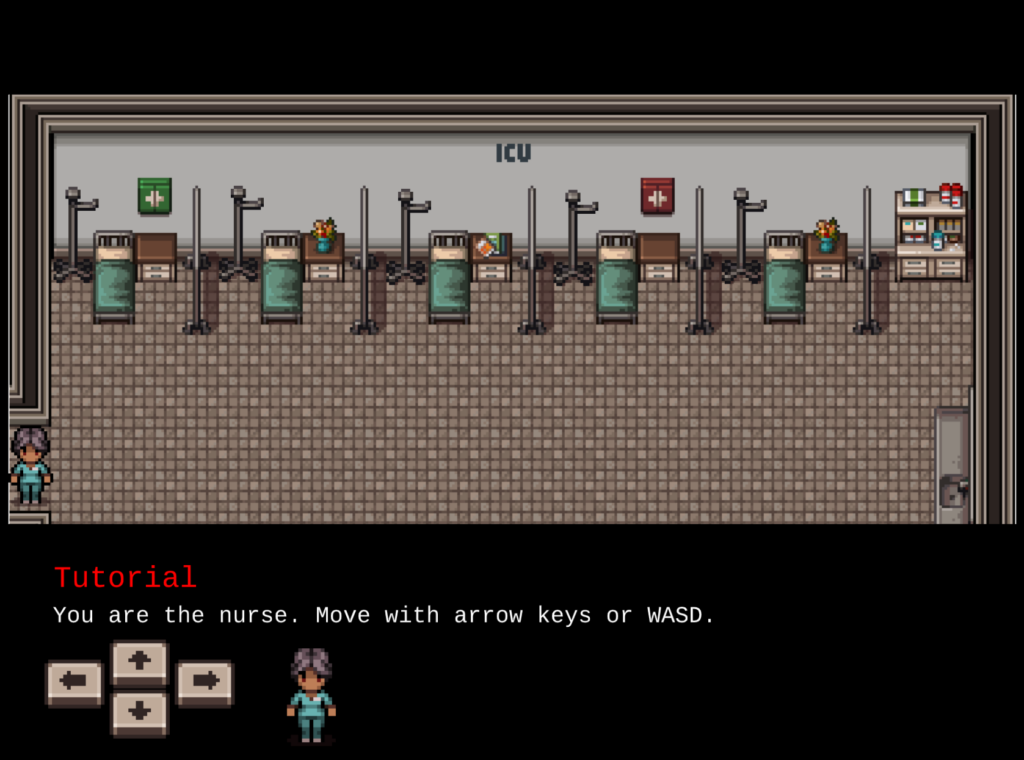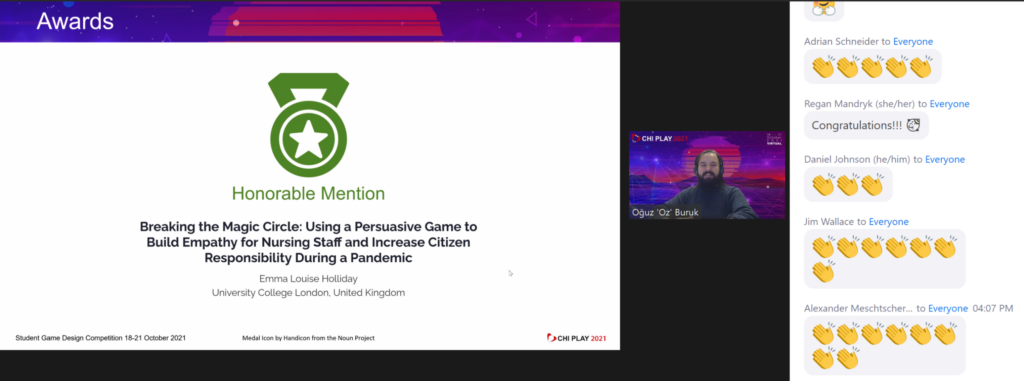A blogpost by Emma Holliday, student on MSc HCI 2019-2021

Getting into the video games industry was originally my inspiration for studying Computer Science. As I learned about the often toxic work environments (and sexism) in the gaming industry, I decided to leave this dream behind and went into software development instead. That’s why I’m so amazed and thrilled to have actually designed and built my own game and, even better, to have won an award for it.
Click here to play the game! Spoilers below!

The game itself was built as part of my coursework for the Serious and Persuasive Games module (led by Prof Anna Cox) on the Human-Computer Interaction course at UCL. (Even though I had somewhat given up on a career in the gaming industry, I still really loved games and would take any excuse to learn about them and play them.) Something that really stood out to me during the lectures was the concept of the “Magic Circle”, an idea that games exist within set boundaries that are separate to the real world. This means that different rules apply within game (e.g. violence is allowed), actions in the game don’t have consequences in the real world, and actions in the real world don’t apply to the game. I immediately challenged this – I’m sure we’ve all had that gaming session that left friendships a little sour even after the game had finished, learnt something new or even strengthened our relationships. I personally believe, particularly with narrative-based games, it is very unlikely to not leave some lasting impression in the real world long after the game has been played. As such, I designed a game that would exploit breaking the “Magic Circle” by including people’s real-world actions into gameplay. My hopes were that, by breaking the “Magic Circle” upfront, this would weaken the boundaries between the game and the real world, encouraging players to take experiences from the game back into real life.
My time studying this module was during the COVID-19 pandemic which also provided a lot of inspiration, largely because it was inescapable and incredibly topical. Other games which we studied during the module were also influential, particularly those on blame culture in nursing (such as Nurse’s Dilemma and Patient Panic). All of this culminated in my game, COVID Ward, where players take on the role of a nurse working in the intensive care unit during the COVID-19 pandemic. The gameplay is quite simple, players use arrow keys to control the nurse and spacebar to administer aid to patients in the ward. Patient health deteriorates over time and they will eventually die if their health becomes too low while fully healed patients are able to leave the ward. The game plays out as levels representing 12 hour shifts, so time is limited and the nurse character can only do so much in a day. In between levels is where the “Magic Circle” is broken; the player is asked a question relating to their real-world actions during the pandemic and their answer affects the number of patients admitted to the ward during the next level. For example, the question may ask if the player always wore a mask while on public transport. If the player answers “no”, there would be more patients in the ward the next day than if they had answered “yes”. Through this, players see the their actions directly associated with the effects on other people and healthcare staff.
The game was refined iteratively thanks to playtesting with my friends, fellow students, and staff on the Serious and Persuasive Games course. Finally, a user study was completed to test if the game had the desired effects of making people feel more responsible for their actions, encouraging them to follow COVID-19 safety guidance more closely and increasing empathy for nursing staff. Though it was a small scale study, initial results were very positive and suggested that the game had achieved its goal in terms of attitude change. Qualitative responses from participants repeatedly mentioned the use of their real world actions and suggested it was both engaging and encouraged them to reflect more deeply on their actions. As such, breaking the “Magic Circle” is a promising technique for persuasive games which warrants further research.
In terms of development, the game was built using Game Salad (a no-code game authoring tool). Though I’m familiar with code, (and there were times I wished I was using code!) GameSalad did provide a really quick way to get started and put ideas together without too much learning overhead. Having since tried to pick up Unity, I can say Game Salad is definitely a lot quicker to get your ideas into something working, which is crucial for iterative development. Game Salad also made it very easy to publish my game so that others could play it online, which helped enormously when getting feedback and conducting the user study as there was no installation or downloads required.
In an early version of the game, everything was represented by incredibly simple shapes and numbers. While I support the concept of primarily using the mechanic to deliver the message, as demonstrated remarkably in Brenda Romero’s games, I felt my game would benefit from graphics and sound effects to help immerse the player and reinforce the narrative that these were real people affected by their actions, encouraging stronger empathy. Given the short time frame (and that I am only one person who is not talented enough to do everything from scratch!) I was exceedingly grateful for assets created by other artists which allowed me to create something that was much more complete than I could have achieved on my own. I found the music by Bio_Unit on Free Music Archive and got sound effects from Kenney.nl (a fantastic source for several free assets!) I paid for some pixel-art assets from Malibu Darby through Humble Bundle which, very fortunately, had a game dev bundle just as I was building the game. I also dabbled in editing the pixel art myself to customise it to my game. If you’d like to give that a go, I recommend aseprite.
Overall, I was really happy with my game and the results of the user study. Prof. Anna Cox had suggested that the class submit their work to the CHI PLAY student game competition. Earlier in my time at UCL, Prof. Catherine Holloway had encouraged us to always try and share our work with the academic community and introduced me to Student Research Competitions. These are often held across different ACM conferences (such as SIGCHI, SIGACCESS, CHIPLAY) and felt much more approachable to me as the level of work expected was closer to what I had already done for my coursework. As such, I decided to go for it and submit my game and a paper detailing the user study to CHI PLAY 2021’s Student Game Design Competition. I didn’t really expect to win anything, but I was just happy to share my game in the hopes it might have a life beyond my university coursework grades.
So I was very excited when I heard back to find out my game had been accepted! It turns out, 8 of the 19 submissions were accepted to the conference as finalists. This did mean, however, that I had a bit more work to do! I updated my paper to respond to the reviewers’ comments, battled with the proper formatting and TAPS submission system (though the support staff are really helpful), and created a reaction video to be played at the conference. I’d be lying if I said it wasn’t stressful (largely because it fell right across the deadline for my final MSc dissertation!!) but it was definitely worth it to see my work presented at the conference and all the interest it generated. Even more so when I was announced as receiving an honourable mention for the competition! I also got to attend the entire conference – though you don’t have to be an author to do so – and joined lots of interesting talks and presentations across all aspects of games.

It was really rewarding finding myself back in the games industry, in a sense, but from a completely different direction than I had ever imagined and one that was much better suited to me and my passions. It was even more rewarding to know that I had contributed to it and that, maybe one day, my research will have an impact on the games I end up playing on my sofa.
Find out more about the competition and see the other entries

